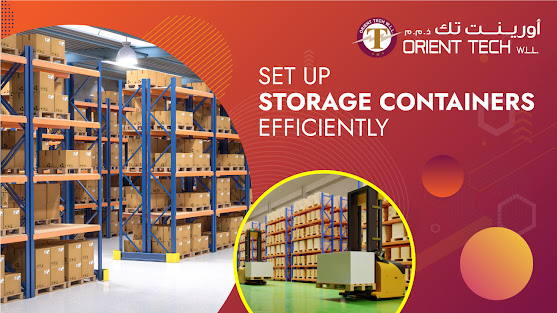Set up Storage Containers Efficiently
Logistics and production companies depend on efficiently planned warehousing to ensure smooth operations.
It is therefore important to use the available storage space as optimally as possible. However, you should consider various aspects when planning your warehouse, because depending on the intended use and spatial conditions, each warehouse must be individually designed and set up.
Data analysis and IT in the warehouse?
Whether master compartments or chaotic storage, small or pallet warehouses, no warehouse can be operated efficiently without warehouse management software. This is not only indispensable in large storage systems but is also recommended even for small companies with a few items in order to find all materials in the warehouse.
In the beginning, you should give specific thought to which goods and materials should be stored in which quantities.
This information is important in order to make the most of your storage space and to avoid vacancies.
However, some people are faced with the problem that the storage data is difficult to record and process. But thanks to modern technology, it is no longer a big problem to save and evaluate all the necessary data about the warehouse, its goods, and their movements.
The high quality of the evaluated data is particularly important here.
Basically, you should make sure that you have enough capacity available even in times of high loads thanks to a generous reserve.
- Optimal storage level: 80 to 90 percent
- a higher degree of filling is often counterproductive in day-to-day operations
You do not yet know which storage system is suitable for you? No problem. Below are 4 types of storage systems for guidance.
Shelf Storage
For the optimal use of space in the three-dimensional storage shell, the facility is equipped with shelves and is suitable both for setting up individual storage spaces and for equipping large logistics centers. However, in a high-bay warehouse, the load-bearing capacity of the base plate must be sufficiently dimensioned to cope with the point and area loads that occur.
The types of shelves commonly used in storage facilities include:
● Pallet racks are used to hold various pallet carriers. They offer the advantage of standardization and easy handling and are available in different versions.
● Shelf racks, which mostly consist of a steel structure and are used in the shelves for storage.
● Flow racks that allow access from two sides. The shelves are operated manually or automatically.
● Cantilever racks are horizontal load carriers that are attached to just one support. They are therefore preferably used for the storage of long goods.
●Mobile shelves that run on floor rails and can be moved manually or automatically. Movable shelves can be designed as pallet shelves, cantilever shelves, or shelf shelves.
● Drive-in shelving that is operated with a forklift that can drive into the shelf.
● Drive-through racks: Structure and operation are the same as drive-in racks. Since the drive-through rack is open on both sides, the first in, first out principle can also be implemented here.
Containers are also required for the storage of many goods. You will find a suitable selection in the Orient Tech shop.
Hand Fan and Paternoster
Hand compartments are the ideal companion for storing small parts. With a manual shelving unit, significantly smaller storage spaces can be set up on one base, which means that you can use the available space more efficiently.
Paternosters are particularly space-saving. However, this does not mean the Latin “Our Father”, but a special camp system. In this, a number of cabins travel in two shafts in a circle, always moving down in one shaft and up in the other shaft. This means that the goods can be stored in the smallest of spaces with little floor space.
If a conveyor connection is planned, shelf systems for small load carriers (KLT) are the best choice. Like the pallet, these represent a standardized load carrier that can be used both in a small parts warehouse (automatic small parts warehouse) and on a container conveyor system.
KLT is also the first choice when it comes to small quantities of bulk goods such as fasteners, small spare parts, or other items. Kanban systems are also often based on KLT, which are additionally provided with a barcode, which enables a quick and reliable inventory and automated reordering.
A, B and C Items
As a rule, a warehouse does not generate revenue, but costs. It is therefore important to keep this as low as possible without jeopardizing the ability to deliver or risking production bottlenecks.
For the warehouse layout, i.e. the spatial design of storage, open and driving areas, the frequency and quantity of goods handled are decisive criteria for the best possible use of space and space. A-items that rotate particularly frequently should be stored in such a way that their storage locations can be reached quickly and with the shortest possible distances, while C-items that rotate slowly, which only receive a few hits per year, should be stored in the peripheral storage areas, e.g. at the end of the aisle or on the should be stored at the highest levels.
Chaotic Storage vs. Trunk and Reserve Compartments
Contrary to what the name suggests, chaotic warehousing is a particularly efficient way of running a warehouse. A prerequisite for this, however, is adequate IT support in the form of warehouse management software that takes over the allocation and management of storage spaces.
If such software is not in use, master compartments are usually used in order to always store items in a fixed location. There are often reserve compartments directly above or below the main compartment set up at working height, in which excess capacities of the article are stored and from which the main compartment can be refilled if necessary. Master and reserve compartments can also be mapped with a warehouse management system, and they are used both in small and very small warehouses and in large warehouses with thousands of storage spaces.
Efficient warehousing, therefore, means going through all the individual steps in the correct sequence with the optimal storage system so that each storage location contains the desired goods in sufficient quantities.



Comments
Post a Comment